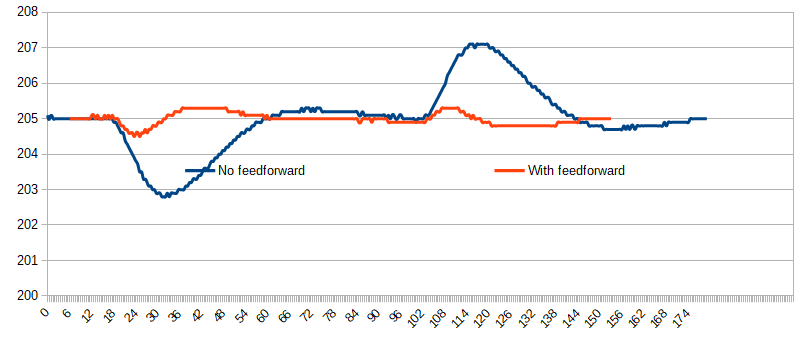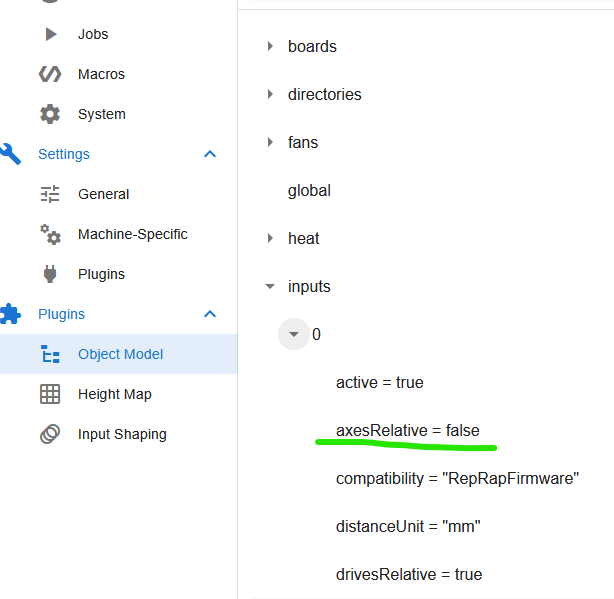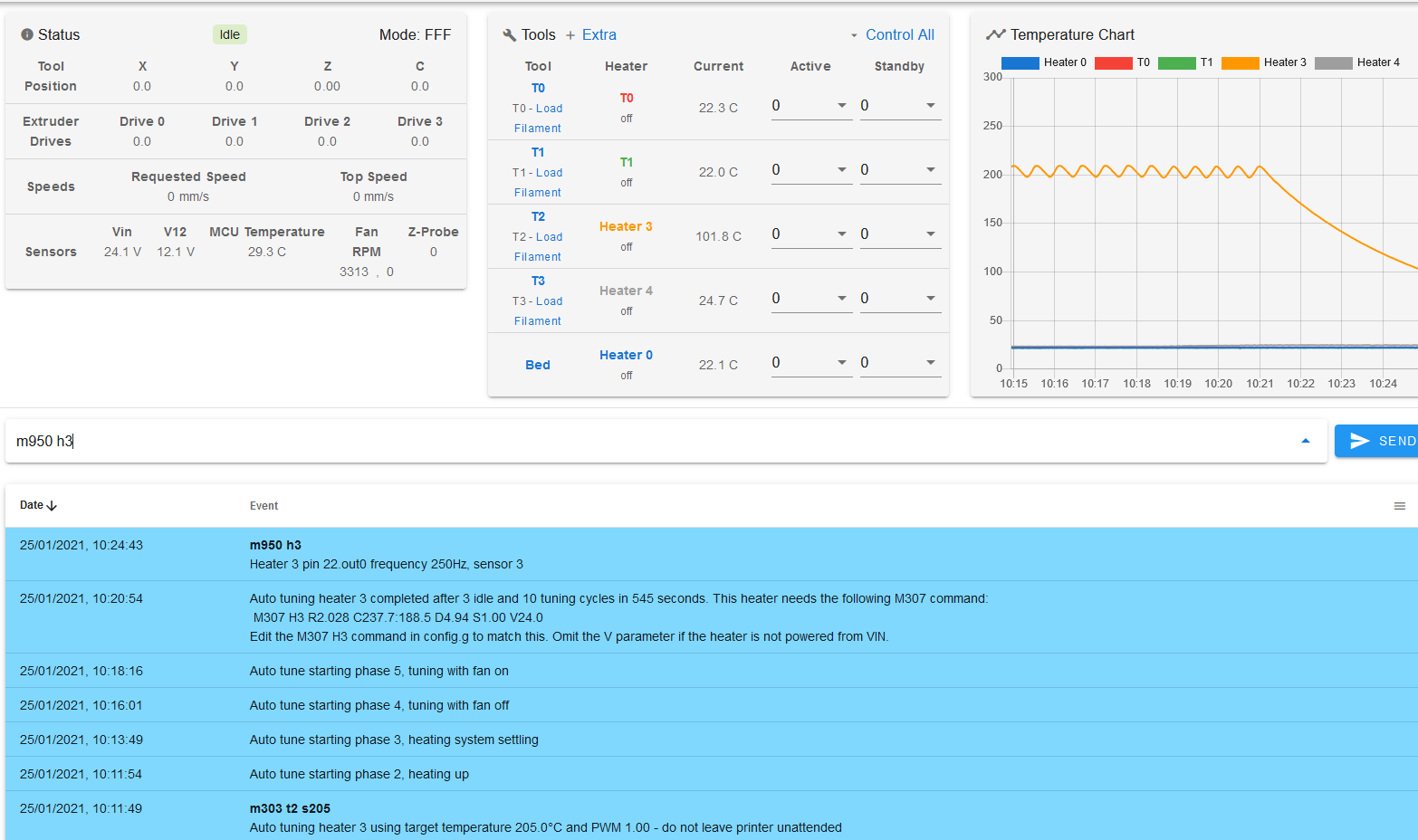Coming soon to a PanelDue near you...

Best posts made by dc42
-
RE: Does anyone here work on Superslicer?posted in General Discussion
-
Software bundle 3.4.0 stable released!posted in Firmware installation
On behalf of the Duet3D team I am please to announce the release of RepRapFirmware, Duet Web Control and Duet Software Framework 3.4.0 stable.
RepRapFirmware 3.4.0 brings more than 90 new and improved features and around 80 bug fixes. New features include:
- Input shaping, to allow faster print speeds without exciting ringing
- Thumbnail image display of print files in Duet Web Control and on PanelDue (requires a compatible slicer and PanelDue firmware 3.4.1-pre2
- Heater feedforward, to maintain more even nozzle temperatures on high flow rate extruders
- More flexible control of power supplies
- More control over machine behaviour when heater faults, stepper driver warnings etc. occur
- Support for the new Duet 3 MB6XD main board for use with external drivers, and the EXP1HCL closed loop stepper motor control board
- Coordinate rotation in the XY plane
Duet Web Control and Duet Software framework now provide:
- Thumbnail image display
- Improved plugin support and new plugin guides for DWC and DSF
- A new HTTP class library for remote control of Duets in standalone and SBC mode
- 12864 display support in SBC mode
Important! If you are upgrading from software 3.3 or earlier, read at least the upgrade notes section of the RRF 3.4.0 release notes to see what alterations if any you may need to make to your configuration and macro files. Users already running 3.4.0RC2 can instead check the abbreviated release notes.
Upgrade instructions:
- For Duet in standalone mode you can find the upgrade files here. Most users can just upload the Duet2and3Firmware-3.4.0.zip file.
- For Duet with attached Single Board Computer, upgrade from the stable feed on the Duet3D package server using apt-get as usual.
Please do not use this thread to report issues with this release that require a response; start a new thread for those instead.
-
New stable firmware bundle 3.2 releasedposted in Firmware installation
On behalf of the Duet 3D team I am pleased to announce RepRapFirmware 3.2 stable. Here are the upgrade instructions:
- If you are running RepRapFirmware 3.0 or later in standalone mode, download Duet2and3Firmware.zip from https://github.com/Duet3D/RepRapFirmware/releases/tag/3.2 and upload it to your Duet via the web interface
- If you are using Duet + SBC, update from the package server in the usual way (
sudo apt-get updatefollowed bysudo apt-get upgrade) - If you are running RepRapFirmware 2.x you will need to upgrade to firmware 3.0 first, then you can immediately upgrade to 3.2. Alternatively, if you are comfortable using Bossa, you can upgrade directly to 3.2 using Bossa.
Upgrade notes and change lists:
- RRF: https://github.com/Duet3D/RepRapFirmware/blob/v3-dev/WHATS_NEW_RRF3.md
- DWC: https://github.com/Duet3D/DuetWebControl/blob/master/WHATS_NEW.md
- DSF: https://github.com/Duet3D/DuetSoftwareFramework/blob/master/WHATS_NEW.md
If you encounter problems with this release, or problems upgrading to it, please start a new thread to describe those issues.
Edit: If you are on the unstable package feed (Duet + SBC), you can update to the latest version as usual again. The corresponding packages have been fixed.
-
RepRapFirmware road map Q1 2021posted in Future Direction
These are our current plans for RRF over the next few months:
RRF 3.2: release candidate 2 appears to be very stable so we plan to release 3.2 final very soon.
RRF 3.3: this is planned to be a short cycle. Work on it has already started. The focus is on making Duet main boards easier to test using our new CAN-based automatic test equipment. As a side-effect of this work, there may be experimental support for using a Duet 3 Mini as a Duet 3 expansion board (see the M954 command), however functionality will probably be limited to driving motors and reading/writing GPIO ports. RRF 3.3 will also increase the maximum number of axes supported to 15, and I expect to provide support for tuning heaters on regular Duet 3 expansion and tool boards. Some other easy-to-implement features may be included. I hope to have a release candidate available by the end of January.
RRF 3.4: the focus of this will be the motion system. We will be looking at input shaping, S-curve acceleration, better cornering algorithms, and other mechanisms to improve print quality. Alongside this we will remove the limitation on using endstops connected to Duet 3 main boards to control motors connected to expansion boards. We expect to start work on this in February. We have a long list of other new features for consideration in this release, including further improvements to the performance of the Duet 3 MB6HC board.
-
New heater tuning algorithmposted in Beta Firmware
I finally found time to implement the new heater tuning algorithm. This algorithm is more accurate than the old one (especially in measuring the dead time), often completes more quickly than the old algorithm, and is more portable to expansion and tool board firmware.
The new algorithm also tunes the heater with related fans both off and on. The purpose of this is to allow the heater control to implement feedforward, which monitors fan PWM changes and adjusts the heater power in advance of the PID algorithm spotting that something has changed. Here is a temperature plot showing the effect on reported hot end temperature when a print cooling fan is turned on and then off, with and without feedforward.

The new algorithm is implemented in RRF 3.2beta3.2 which I hope to release later today. Subject to the feedback I receive from beta testers, I hope to include it in tool and expansion board firmware too in the RRF 3.2 final release.
-
RepRapFirmware 3.0 is released!posted in Firmware installation
I am pleased to announce the release of RepRapFirmware 3.0, the first stable release in the RepRapFirmware 3 series.
Users of Duet 3 with attached Raspberry Pi can upgrade to it using apt-get update and apt-get upgrade as usual, from either the stable or the unstable package feed.
Duet 2 users and Duet 3 users running in standalone mode can download it from https://github.com/dc42/RepRapFirmware/releases/tag/3.0. Most users should be able to upgrade just by uploading the .zip file to /sys in Duet Web Control.
If you are currently using RepRapFirmware 2.x, you will need to make significant changes to your config.g file when upgrading to RRF3. See https://duet3d.dozuki.com/Wiki/RepRapFirmware_3_overview#Section_Summary_of_what_you_need_to_do_to_convert_your_configuration_and_other_files for details. You should read this thoroughly and plan your migration to RRF3.
Now that RepRapFirmware 3 is released, I do not plan to do any further releases of RepRapFirmware 2.x or 1.x. But of course it is possible for others to fork the repository and do their own amendments to 1.x and 2.x.
-
Software package 3.3beta3 releasedposted in Beta Firmware
On behalf of the Duet3D team, I am pleased to announce the release of software package 3.3beta3. This release brings the following:
- Global variables are now included in the object model. This means they can be viewed in the DWC Object Model browser and can be accessed by SBC add-ons.
- The DWC Object Model browser now provides a summary of what each value means
- RRF and DWC now support accelerometers (currently in standalone mode only) in preparation for the forthcoming support for input shaping. See https://duet3d.dozuki.com/Wiki/Accelerometers.
- Many other minor improvements and bug fixes
RRF release notes: https://github.com/Duet3D/RepRapFirmware/wiki/Changelog-RRF-3.x-Beta-&-RC#reprapfirmware-33beta3
DWC release notes: https://github.com/Duet3D/DuetWebControl/releases/tag/v3.3-b3
DSF release notes: https://github.com/Duet3D/DuetSoftwareFramework/releases/tag/v3.3-b3Users of Duet + SBC can upgrade from the unstable package server.
Users of Duet in standalone mode can upgrade using the files at https://github.com/Duet3D/RepRapFirmware/releases/tag/3.3beta3. The IAP files have not changed but they are included in this release because some users may need to re-upload them to put them in the correct folder on the SD card.
-
RE: Duet hardware actually makes it into Thomas Salanderer's videosposted in General Discussion
A genuine Einsy Rambo board is $120 on Ultimachine's web site, and it has only 4 stepper drivers, an 8-bit processor and no web interface. So I think $130 is in the right ball park for a high-quality board that comes with support and a warranty. In time I expect the price will come down.
MKS can only sell boards as cheaply as they do by parasitising open source designs, violating the open source license agreements, offering no support and little or no warranty, and selling boards before they have got the design right (as happened with the SBase). We're not like that.
-
RE: Email/notifications from Duet wifiposted in Duet Web Control
Our latest thoughts about this are to embed a MQTT client in RRF that publishes messages about the current state of the printer e.g. printer powered up, print started, print completed, print paused by filament monitor.
Latest posts made by dc42
-
RE: help with optimizing heater temperatureposted in Tuning and tweaking
@jltx said in help with optimizing heater temperature:
For anyone who stumbles on this, Orca looks at your start gcode and if it doesn't see any heater command (because you use a macro, for example) then it injects its own before any of your own gcode is emitted.
This is standard behaviour of all the slicers I have used.
-
RE: Is less damping factor (larger value) better for input shaping?posted in Tuning and tweaking
@jltx the selected damping factor doesn't greatly affect fine details on the print. It should ideally match the damping factor of the ringing that you are trying to cancel. It's most useful when you have a single well-defined ringing frequency that you want to cancel using one of the simpler forms of input shaping such as ZVD. When using the higher order input shaping methods such as EI2, EI2 and ZVDDD to cancel multiple frequencies, it's probably best to set it to 0.05 or even 0.
-
RE: resume misses first Z moveposted in Beta Firmware
@jltx please post your pause.g and resume.g files.
-
RE: Exceeded Position Toleranceposted in Tuning and tweaking
@ash100 I guess you haven't run PID tuning since you were running firmware 3.4.x. I suggest you upgrade to either 3.5.4 or 3.6.0-rc.3 and then run PID tuning again. It has changed a lot since 3.4.x so read https://docs.duet3d.com/en/User_manual/Tuning/Duet_3_1HCL_tuning#manual-tuning for instructions.
-
RE: help with optimizing heater temperatureposted in Tuning and tweaking
@jltx said in help with optimizing heater temperature:
I am trying to optimize my print start times by kicking off some prep work just prior to the bed reaching temperature (the long pole).
I pass the bed temp as param.B and use an expression to subtract 5 degrees. I wait for that to reach the then set final bed temp and nozzle temp without waiting, and kick off bed leveling, etc while those finish.
However, this does not work. It just heats up the bed to full temp every time before anything else. So either the expression does not work here or I don't understand how heater requests are queued by the firmware. Any help? This is 3.6 but behaved the same on 3.5.
; set bed and hotend temps M190 S{param.B-5} ; set bed up to last 10 degress M568 P0 R170 S{param.A} ; set nozzle to first layer temp M140 S{param.B} ; finish bed to first layer temp T0 ; select tool 0 ...That should work, unless either your tpre0.g or tpost0.g file waits for heating to finish. Do they?
Another trick you can do to speed up hot end heating is to set the hot end standby temperature to the active temperature minus e.g. 50C (low enough to avoid oozing) and switch the heater to standby. Then set the bed temperature and wait for it. When that command completes, probe the bed, then select the tool, which will switch the heater to active.
-
RE: Core XY high speed closed loop tuningposted in Tuning and tweaking
@Tech_Sam03 before you added the D ter you had a lot of ringing in the P term. You would also have seen this in the Current Error had you plotted it. That's an indication that the P term is too large. A small amount of ringing can be countered by adding a small D term, but as you discovered, larger D terms make the motor noisier.
-
RE: Where can I access persistent state?posted in Beta Firmware
@jltx It's in the object model, separately for each source of GCodes.

-
RE: Duet2 Wifi, sensorles homingposted in General Discussion
@mrjoneskod RRF on Duet 2 and Duet 3 6HC boards polls the status of all drivers over SPI at frequent intervals, thereby getting the complete driver status including open load, short circuit, over temperature etc. flags as well as the stall status.
On Duet 3 Mini it uses the individual DIAG outputs of the drivers to detect stalls instead, because the UART interface to the drivers on that board is much slower.
-
RE: Z-Probe (Klicky) frequently not triggeredposted in Beta Firmware
@effnish thanks for confirming. This change is included in 3.6.0-rc.3 released yesterday.
